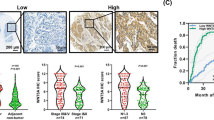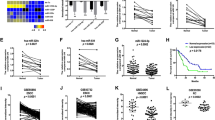Abstract
The glioma-associated oncogene homolog 1 (GLI1) family of zinc finger transcription factors is the nuclear mediator of the Hedgehog pathway that regulates genes essential for various stages of tumor development and progression. However, the role and mechanism by which high expression of GLI1 contributes to the invasion and metastasis of human esophageal squamous cell cancer (ESCC) has not been fully elucidated. In the present study, we demonstrated that GLI1 was over-expressed in human ESCC tissues, especially in ESCC tissues with deep invasion and lymph-node metastasis. Moreover, GLI1 was also over-expressed in ESCC cell lines and correlated with the aggressiveness of ESCC cell lines. In addition, GLI signaling pathway agonist purmorphamine could increase the invasion and metastasis ability of ESCC cells in vitro. There is increasing evidence for the contribution of epithelial–mesenchymal transition (EMT) to ESCC invasion and metastasis, therefore we investigated GLI1’s role in EMT. Our results showed that high expression of GLI1 dampened expression of E-cadherin and enhanced the expression of Vimentin, and it also improved the expression of Snail, indicative of its role in EMT occurrence. Mechanistic studies showed that down-expression of Snail reversed GLI1 activation-regulated expression of EMT markers, suggesting the role of Snail in GLI1-mediated EMT. Taken together, our results had revealed that GLI1 could participate in the invasion and metastasis of ESCC through EMT. These studies indicated that in ESCC, GLI1 could be a useful target for cancer prevention and therapy.
This is a preview of subscription content, access via your institution
Access options
Subscribe to this journal
Receive 12 print issues and online access
$259.00 per year
only $21.58 per issue
Buy this article
- Purchase on Springer Link
- Instant access to full article PDF
Prices may be subject to local taxes which are calculated during checkout





Similar content being viewed by others
References
Qi YJ, Chao WX, Chiu JF . An overview of esophageal squamous cell carcinoma proteomics. J Proteomics 2012; 75: 3129–3137.
Sun L, Yu S . Meta-analysis: non-steroidal anti-inflammatory drug use and the risk of esophageal squamous cell carcinoma. Dis Esophagus 2011; 24: 544–549.
Pan Y, Han J, Zhang Y, Li XJ . Role of vimentin in tumor metastasis and drug research. Sheng Li Ke Xue Jin Zhan 2010; 41: 413–416.
Theveneau E, Mayor R . Neural crest delamination and migration: from epithelium-to-mesenchyme transition to collective cell migration. Dev Biol 2012; 3661: 34–54.
Myong NH . Loss of E-cadherin and acquisition of vimentin in epithelial-mesenchymal transition are noble indicators of uterine cervix cancer progression. Korean J Pathol 2012; 46: 341–348.
Smith BN, Odero-Marah VA . The role of Snail in prostate cancer. Cell Adh Migr 2012; 6: 433–441.
Matsuo N, Shiraha H, Fujikawa T, Takaoka N, Ueda N, Tanaka S et al. Twist expression promotes migration and invasion in hepatocellular carcinoma. BMC Cancer 2009; 18: 240.
Adam L, Zhong M, Choi W, Qi W, Nicoloso M, Arora A et al. miR-200 expression regulates epithelial-to-mesenchymal transition in bladder cancer cells and reverses resistance to epidermal growth factor receptor therapy. Clin Cancer Res 2009; 15: 5060–5072.
Heldin CH, Vanlandewijck M, Moustakas A . Regulation of EMT by TGFβ in cancer. FEBS Lett 2012; 586: 1959–1970.
Li Y, Maitah MY, Ahmad A, Kong D, Bao B, Sarkar FH . Targeting the Hedgehog signaling pathway for cancer therapy. Expert Opin Ther Targets 2012; 16: 49–66.
Barginear MF, Leung M, Budman DR . The hedgehog pathway as a therapeutic target for treatment of breast cancer. Breast Cancer Res Treat 2009; 116: 239–246.
Onishi H, Katano M . Hedgehog signaling pathway as a therapeutic target in various types of cancer. Cancer Sci 2011; 102: 1756–1760.
Katoh Y, Katoh M . Hedgehog target genes: mechanisms of carcinogenesis induced by aberrant hedgehog signaling activation. Curr Mol Med 2009; 9: 873–886.
Lauth M, Toftgård R . Non-canonical activation of GLI transcription factors: implications for targeted anti-cancer therapy. Cell Cycle 2007; 6: 2458–2463.
Clement V, Sanchez P, de Tribolet N, Radovanovic I, Ruiz i Altaba A . HEDGEHOG-GLI1 signaling regulates human glioma growth, cancer stem cell self-renewal, and tumorigenicity. Curr Biol 2007 23 17: 165–172.
Remmele W, Hildebrand U, Hienz HA, Klein PJ, Vierbuchen M, Behnken LJ et al. Comparative histological, histochemical, immunohistochemical and biochemical studies on oestrogen receptors, lectin receptors, and Barr bodies in human breast cancer. Virchows Arch A Pathol Anal Histopathol 1986; 13: 127–147.
Javelaud D, Pierrat MJ, Mauviel A . Crosstalk between TGF-β and hedgehog signaling in cancer. FEBS Lett 2012; 586: 2016–2025.
Marini KD, Payne BJ, Watkins DN, Martelotto LG . Mechanisms of Hedgehog signalling in cancer. Growth Factors 2011; 29: 221–234.
Tiwari N, Gheldof A, Tatari M, Christofori G . EMT as the ultimate survival mechanism of cancer cells. Semin Cancer Biol 2012; 22: 194–207.
Rangel MC, Karasawa H, Castro NP, Nagaoka T, Salomon DS, Bianco C . Role of Cripto-1 during epithelial-to-mesenchymal transition in development and cancer. Am J Pathol 2012; 180: 2188–2200.
Hu YY, Zheng MH, Zhang R, Liang YM, Han H . Notch signaling pathway and cancer metastasis. Adv Exp Med Biol 2012; 727: 186–198.
Wells A, Yates C, Shepard CR . E-cadherin as an indicator of mesenchymal to epithelial reverting transitions during the metastatic seeding of disseminated carcinomas. Clin Exp Metastasis 2008; 25: 621–628.
Katoh M . Epithelial-mesenchymal transition in gastric cancer (Review). Int J Oncol 2005; 27: 1677–1683.
Fearon ER . Connecting estrogen receptor function, transcriptional repression, and E-cadherin expression in breast cancer. Cancer Cell 2003; 3: 307–310.
Gloushankova NA . Changes in regulation of cell-cell adhesion during tumor transformation. Biochemistry (Mosc) 2008; 73: 742–750.
Acknowledgements
This work was supported by grants from the Medical Science and Technology Program of He’nan Province. We thank Professor Fan Qingxia (Zhengzhou University, Zhengzhou, Henan, China) for her generous help.
Author information
Authors and Affiliations
Corresponding author
Ethics declarations
Competing interests
The authors declare no conflict of interest.
Additional information
Supplementary Information accompanies the paper on Cancer Gene Therapy website
Supplementary information
Rights and permissions
About this article
Cite this article
Min, S., Xiaoyan, X., Fanghui, P. et al. The glioma-associated oncogene homolog 1 promotes epithelial–mesenchymal transition in human esophageal squamous cell cancer by inhibiting E-cadherin via Snail. Cancer Gene Ther 20, 379–385 (2013). https://doi.org/10.1038/cgt.2013.36
Received:
Accepted:
Published:
Issue Date:
DOI: https://doi.org/10.1038/cgt.2013.36
Keywords
This article is cited by
-
Premalignant pancreatic cells seed stealth metastasis in distant organs in mice
Oncogene (2021)
-
Cripto-1 acts as a functional marker of cancer stem-like cells and predicts prognosis of the patients in esophageal squamous cell carcinoma
Molecular Cancer (2017)
-
Gli1, a potential regulator of esophageal cancer stem cell, is identified as an independent adverse prognostic factor in esophageal squamous cell carcinoma
Journal of Cancer Research and Clinical Oncology (2017)
-
Crosstalk between SHH and stemness state signaling pathways in esophageal squamous cell carcinoma
Journal of Cell Communication and Signaling (2017)
-
Protein arginine methyltransferase 1 interacts with Gli1 and regulates its transcriptional activity
Tumor Biology (2016)



